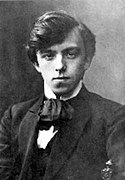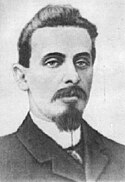Waclaw Szymanowski Kariatydy 1896
Ciężar (Kariatydy, Grupa) Burden (Caryatids, Group) Wacław Szymanowski, 1896
On the paths of the soul, the exhibition in the National Museum (Muzeum Narodowe) in Kraków.
Wacław Szymanowski (1859–1930) was a Polish sculptor and painter who created under the influence of Auguste Rodin. He studied in École des Beaux-Arts in Paris, and later in Akademie der Bildenden Künste München. Until about 1895 the painter-cum-sculptor occupied himself mainly with executing genre paintings of Polish mountaineers and Hutsuls, and portraits. He then turned to sculpture, creating compositions in Art Nouveau-Symbolist style. Wacław Szymanowski is the author of the famous monument of Chopin in the Royal Baths Park (Łazienki) in Warsaw. It was created around 1904. The original monument was cast in Paris (it won the first prize in a competition in 1909), but it was officially opened in the Royal Bath Park in 1926. During the Second World War, in 1940 the monument was blown up by Germans, and its remains were cut with gas burners. The Germans were also trying to find and destroy all existing replicas of the sculpture, but luckily they did not succeed. The sculpture was reconstructed and replaced in 1958. Szymanowski's other most notable works include the wooden sculpture "Fala" (Wave, 1903), and the monument to Artur Grottger in Planty Park in Kraków (1907).
His Opus Vitae was a monumental composition "Pochód na Wawel" (A March to Wawel, 1911-1912) that the author was going to place at the Royal Wawel Castle in Kraków, closing the arcaded courtyard from the west. The sculptures (52 statues) represent Polish monarchs and other historic and allegorical figures. The controversial project has never been realized, but a bronze model of the composition can be seen in the Wawel Art Collection.- Uploaded by Szczebrzeszynski
Relevantní obrázky
Relevantní články
Mladé PolskoMladé Polsko je označení pro polské umělecké hnutí z přelomu 19. a 20. století, projevující se v literatuře, v hudbě a ve výtvarném umění. Název poprvé použil roku 1898 literární kritik Artur Górski (1870–1959) v cyklu článků o polské literatuře, uveřejňovaných v časopise Życie, který redigoval propagátor parnasismu Zenon Przesmycki (1861–1944). .. pokračovat ve čtení


































